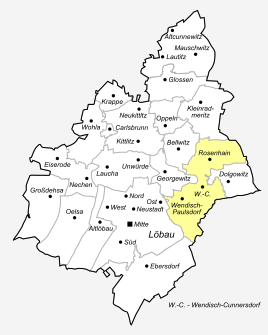Rosenhain (Löbau)
|
Rosenhain
City of Löbau
Coordinates: 51 ° 7 ′ 25 ″ N , 14 ° 43 ′ 26 ″ E
|
|
|---|---|
| Area : | 3.7 km² |
| Residents : | 698 (1990) |
| Population density : | 189 inhabitants / km² |
| Incorporation : | March 1, 1994 |
| Postal code : | 02708 |
| Area code : | 03585 |
|
Location of Rosenhain in the area of the city of Löbau
|
|
Rosenhain ( Upper Sorbian Róžany ) is a district of the Saxon town of Löbau in the district of Görlitz in Upper Lusatia . The place is northeast of Löbau city center on Rosenhainer Wasser . Surrounding districts are Kleinradmeritz in the north, Zoblitz (district of Reichenbach ) in the east, Dolgowitz and Wendisch-Cunnersdorf in the south and Bellwitz in the west. The present-day Löbauer districts Wendisch-Cunnersdorf and Wendisch-Paulsdorf also belonged to Rosenhain until it was incorporated into Löbau .
| year | Residents |
|---|---|
| 1777 | 6 obsessed man,
16 gardeners, 6 cottagers |
| 1834 | 240 |
| 1871 | 253 |
| 1890 | 258 |
| 1910 | 298 |
| 1925 | 274 |
| 1939 | 694 |
| 1946 | 994 |
| 1964 | 848 |
| 1990 | 698 |
history
Rosenhain was first mentioned in a document in 1317 and was assigned to the jurisdiction of the city of Löbau that year. The place is probably much older, however. According to the type of settlement, Rosenhain is a Waldhufendorf , in which a Vorwerk already existed in 1345. The manor mentioned in 1619 emerged from this . In 1777 shares of Rosenhain belong to the manor district of the neighboring town of Bellwitz. Other parts of the village were assigned to different manors, so that there was a strong fragmentation of the corridor. In terms of church, Rosenhain is parish after Kittlitz and Bischdorf .
Since 1847 the Görlitz – Dresden railway has been running over Rosenhainer Flur, for which a 30 meter long bridge had to be built over the Rosenhainer Wasser. However, the place does not have a train station.
Sorbian was also spoken in Rosenhain until the late 19th century . Arnošt Muka determined a population of 248 in 1884/85, including 225 Germans and 23 Sorbs (9%). These spoke the now extinct Löbauer dialect . In 1956 Ernst Tschernik had just counted two speakers in the community.
On April 1, 1939, the neighboring villages of Wendisch-Paulsdorf and Wendisch-Cunnersdorf were incorporated into Rosenhain and officially renamed Rosenhain II and Rosenhain III . This name change took place in the sense of the National Socialist Germanization policy , according to which place names with Slavic origin should be renamed. In 1974 Dolgowitz was incorporated. On March 1, 1994, Rosenhain joined Löbau as a district.
Manor
For the Rosenhain manor, first mentioned in 1619, various residential and farm buildings were built over the years, some of which have been preserved to the present day. In addition to stables, mills and farm buildings, the remains of the two former mansions can still be seen.
- Old Castle: The building was erected around 1619 as probably the first manor of the manor. The simple building has a rectangular floor plan and originally had a steep hipped roof with a turret. Around 1890 it was converted into a workers' house. In 1916 the building was badly damaged in a fire and shortly afterwards rebuilt in its present form.
- New castle : The new castle was built around 1885 for the then manor owner Eckoldt in the style of a stately villa. During the GDR era, the roof and top floor were removed and the house changed beyond recognition. The remaining building fabric served as the company kitchen for the local LPG.
Watermills
Rosenhain was once of economic importance as a mill location. At times there were three water mills in the village, which got their driving power from the Rosenhainer water. The Obermühle was located in the Oberdorf below today's road bridge on federal highway 6, right next to the railway viaduct. The property has been used as a residential building since around 1950. Below the upper mill was the Niedermühle , which was demolished after 1945. The third watermill was the manor mill, which belonged to the manor, right next to the old castle.
Individual evidence
- ↑ Ernst Tschernik: The development of the Sorbian population . Akademie-Verlag, Berlin 1954.
- ^ Ludwig Elle: Language policy in the Lausitz . Domowina-Verlag, Bautzen 1995, p. 253 .
- ↑ a b c d website for the Löbauer districts
- ↑ Municipalities 1994 and their changes since January 1, 1948 in the new federal states , Metzler-Poeschel publishing house, Stuttgart, 1995, ISBN 3-8246-0321-7 , publisher: Federal Statistical Office
- ↑ Cornelius Gurlitt: Descriptive representation of the older architectural and art monuments of the Kingdom of Saxony , Volume 34 (Amtshauptmannschaft Löbau), Dresden 1910, p. 512 f.
Web links
- Rosenhain in the Digital Historical Directory of Saxony
- Information about Rosenhain on the website of the city of Löbau
- Photos and local information about Rosenhain
